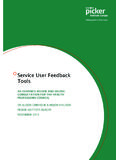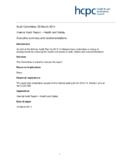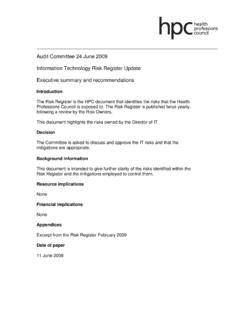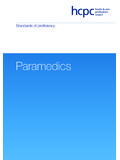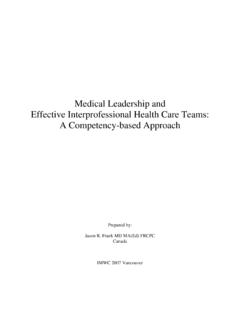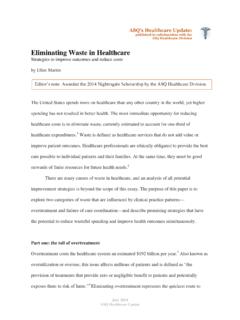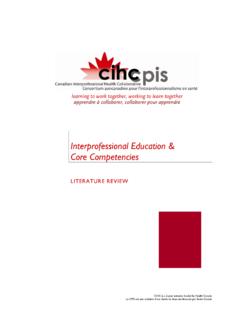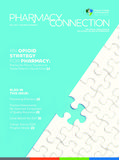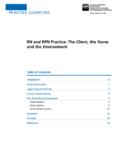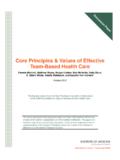Transcription of HCPC’s standards of education and
1 Preparation for practice: The role of the HCPC's standards of education and training in ensuring that newly qualified professionals are fit to practise Professor Mary Chambers Dr Gary Hickey Giulia Borghini Rachael McKeown Faculty of Health, Social Care and education Kingston University and St George's, University of London I. Acknowledgements We wish to thank the Health and Care Professions Council (HCPC) for commissioning the research. We also wish to thank members of the Advisory Group for their guidance, help and support throughout the project. Thanks also go to all those colleagues in Higher education Institutions who allowed us to use their premises and gave us assistance recruiting participants. To all Service Users and other study participants, we wish to acknowledge the time and energy you gave to the project for which we are most grateful and we take this opportunity to thank you.
2 I. Executive Summary Background The HCPC is a regulator of 16 health and social care professions. Its role includes ensuring that education and training programmes meet standards of education and training (SETs) and that newly qualified professionals are fit to practise. These SETs apply to all 16 professions and cover the following areas: level of qualifications for entry to the register, admissions, programme management and resources, curriculum, practice placements and assessment. To ensure that the SETs are contemporary and relevant they are reviewed regularly. It is as part of such a review that this research was commissioned. Purpose and objectives of the project The overall aim of this project is to explore preparation for practice' of newly qualified professionals who have completed pre-registration education and training programmes approved by the HCPC.
3 Evidence gained from this project will inform and assist the HCPC in decision-making regarding the SETs (and supporting guidance) required when preparing newly qualified professionals to be fit to practise. The project objectives were to: Identify the factors (including SETs and guidance), and how they combine and contribute towards ensuring fitness to practise'. Determine how Higher education Institutions (HEIs) implement, and measure as outcomes, the HCPC SETs within curricula Explore the views of healthcare managers, educators, experienced professionals and newly qualified regarding preparedness to practise (including the extent to which they meet the HCPC standards of proficiency). Explore the views of newly qualified professionals, educators, students, service users, patients, carers, practice placement educators, experienced professionals and employers on the appropriateness and completeness of current SETs and supporting guidance Determine the extent to which the pre-registration education programmes (incorporating HCPC SETs) prepare newly qualified professionals for the challenges of interprofessional working and public and patient involvement (PPI).
4 Produce recommendations for how the SETs (and their supporting guidance and any other factors/key issues that contribute to fitness for practice) for newly qualified professional groups regulated by the HCPC, may be amended and/or strengthened. II. Methods The study was undertaken using a four-stage, interdependent sequential mixed method approach, which includes both qualitative and quantitative methods of data collection and analysis. Following a literature review (stage 1), an online questionnaire survey (stage 2) was designed and circulated among our sample. The literature review and preliminary analysis of the questionnaire data informed the questions asked at the data collection events (stage 3), which included world caf s, focus groups and individual interviews. Finally, a consensus workshop (stage 4) with key informants was carried out.
5 Findings The HCPC's definition of fitness to practise' is consistent with that of other professions and regulators. There is one issue, included in the General Medical Council's definition, and not elsewhere, that relates to the relationship between the practitioner and patient. Our research findings also revealed concern, often from service users, that some health and social care professionals are unable to relate to service users in an appropriate way. Generally speaking newly qualified professionals were regarded as adequately prepared for practice albeit with some concerns about the ability of some to relate to service users and carers. There were also concerns about the impact of the variability of both the placement experience as well as the role and training of the practice educator.
6 The data suggests that the vast majority of respondents see the standards as either very important or important regarding ensuring fitness to practise, and that there was no appetite for additional SETs. Course directors are more likely to rate the standards as very important or important. For every standard 80% of course directors rated it as either important or very important. Both course directors and newly qualified professionals were most likely to rate the standards relating to practice placements' as important, with all being rated by 90% as very important or important. The standards relating to programme management and resources' produced the lowest percentages of newly qualified professionals who rated them as very important or important. Where issues were raised with the standards they tended to be a concern about how best to implement them.
7 There was a recognition that SETs, that have to cover 16. professions, will need to be generic so as to provide sufficient flexibility rather than specific and prescriptive. It is the SoPs and the requirements of professional bodies which provide more profession specific criteria. Currently, however, some respondents reported that these different standards and requirements are not sufficiently joined up. III. SET states that The admissions procedures must apply selection and entry criteria, including evidence of a good command of reading, writing and spoken English.' Our findings showed that there were variations in how good command'. was interpreted and applied. SET states that The admissions procedures must apply selection and entry criteria, including compliance with any health requirements.
8 ' The findings revealed concerns about the lack of clarity on this and also that the HCPC does not make explicit mention of mental health. SET states Service users and carers must be involved in the programme.' The results have shown that some HEIs struggle to involve service users and carers effectively. Despite the importance of effective collaboration between professions, there have been a number of difficulties for some HEIs in implementing interprofessional learning within the curriculum. In terms of practice placements, the findings indicate huge variety in the placement experience. Key issues are the length of placements, the difficulties of matching theory and practice and lack of clarity of the role of practice educator. SET states The measurement of student performance must be objective and ensure fitness to practise'.
9 Some respondents were concerned about how much objectivity was actually possible especially as the measurement of student performance must be objective'. SET includes the word aegrotat'. Many respondents were unclear of the meaning. Recommendations The findings presented the following recommendations to be considered by the HCPC. Recommendation 1 The HCPC should consider adding a reference to the development of relationships with service users to their definition of fitness to practice Recommendation 2 The HCPC should consider making an explicit mention of soft skills' within current SETs Recommendation 3 The HCPC's SETs and guidance should include stronger links to SoPs and HCPC's standards of conduct, performance and ethics, and also the standards and requirements of IV. professional bodies.
10 Suggestions include: URL link Explicit link within the introduction to the SoPs and standards of conduct, performance and ethics, and professional body guidance Recommendation 4 The HCPC to consider providing a minimal IELTS score for students whose first language is not English, seeking a place on HCPC regulated courses Recommendation 5 The HCPC to make a clear link, in their SETs and guidance, to the document Health, disability and becoming a health and care professional'. Recommendation 6 The HCPC to make explicit mention of mental health' within the SETs or guidance Recommendation 7 The HCPC to review practice educator training with a view to developing broad principles about the role of practice educators Recommendation 8 The HCPC to consider the development of a how to' practice guide to complement the SETs and the guidance Recommendation 9 Re-word the SET Suggestions are: Replace must' with should aim to be'.
